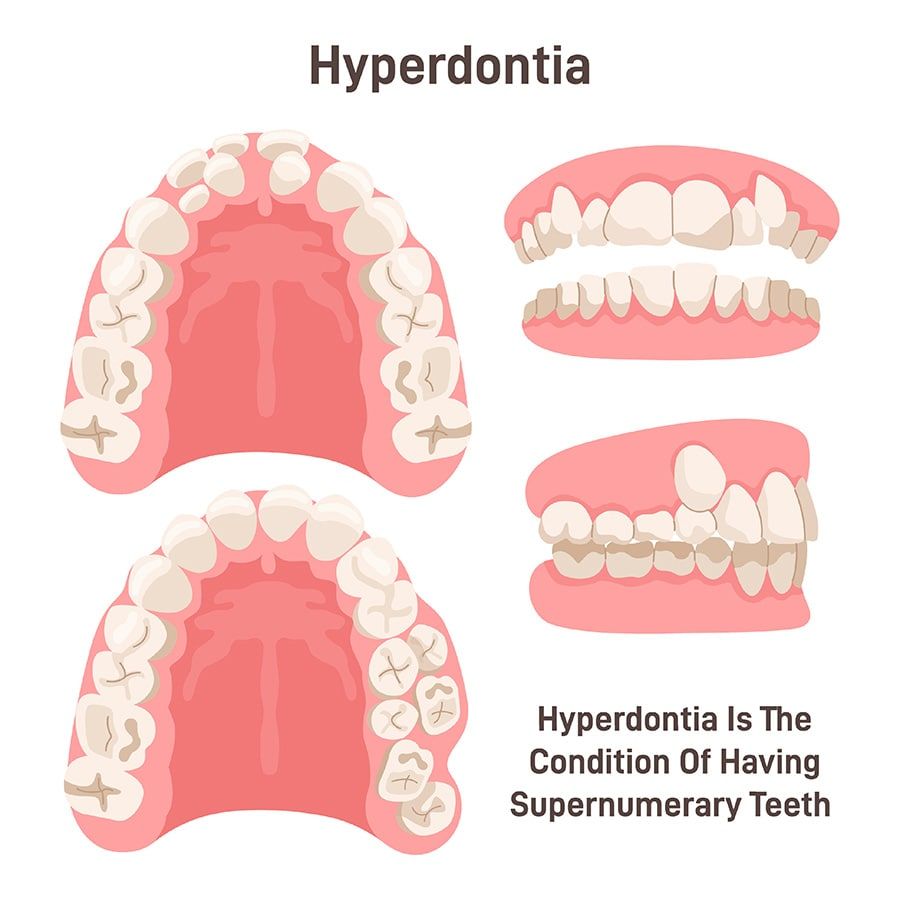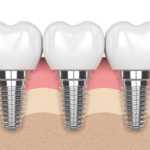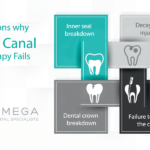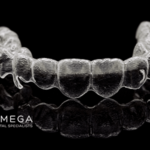What is Hyperdontia?

Hyperdontia is a dental condition characterized by excess teeth within the mouth of a child or an adult. These extra teeth are termed supernumerary teeth that erupt in addition to a child’s 20 baby teeth (primary teeth), or an adult’s 32 permanent teeth. Normally, teeth are arranged equally around the dental arch, in a single crescent arrangement. With Hyperdontia, the additional teeth will erupt behind the pre-existing teeth, and can also cause displacement of a permanent tooth.
By the age of 12, a child’s primary teeth are generally fully shed and are replaced by permanent adult teeth. When Hyperdontia occurs, an extra tooth will grow from the dental palate. In some cases, multiple extra teeth will grow and may be associated with other orofacial abnormalities. In opposition to Hyperdontia is a condition in which a child will develop fewer teeth than normal as they progress into adulthood, termed Hypodontia.
Table of Contents
Why Do Extra Teeth Develop?
Hyperdontia is considered a developmental condition which will occur twice as often in males, compared to females. While the exact cause of Hyperdontia is unknown, over-activity of the dental lamina (the cells which will formulate a tooth) during tooth development, genetics, and even environmental factors are thought to play a role. Additional teeth are more common during permanent tooth development as opposed to a child’s first set of primary teeth.
The extra teeth that develop can be classified by the tooth shape and its position within the mouth. A supernumerary tooth can exhibit the normal shape of the teeth in that series, or they can be identified by their abnormal shape. Tuberculate (barrel-shaped), conical (peg-shaped), and compound odontoma (multiple small tooth-forms) are recognizable tooth shapes of Hyperdontia.
How are Supernumerary Teeth Classified by Position?
Supernumerary teeth are further classified by their positioned outside the dental arch and are thus diagnosed as either Mesiodens, Aramolar, or Distomolar.
-
Mesiodens
Mesiodens is the most common supernumerary tooth and will present in the midline between the two central incisors (the sharp, chisel-shaped front teeth ). These extra teeth are most often conical in shape and are quite rare in the primary teeth of a child.
-
Paramolar
Paramolar is considered an extra molar (teeth used for grinding food) that are typically small and underdeveloped. Paramolar occurs less often but will most often mal-erupt on the side of and near the upper second and third molars.
-
Distomolar
A supernumerary tooth located in the region behind the third molar tooth (hence the term fourth molar). This extra molar will generally be smaller than a normal molar and in rare cases will occur in multiples.
Positional problems associated with Hypodontia include crowding and misalignment of normal teeth, the fusing together with permanent teeth, and the improper chewing of food. The position of supernumerary teeth and whether the tooth is exposed or impacted will determine the appropriate dental treatment protocol.
What are the Treatment Options For Hyperdontia?
The treatment of Hyperdontia includes an evaluation to detect the type, position, and the number of extra teeth. This includes X-rays and CBCT to determine if any supernumerary teeth are not yet erupted, lying beneath the gums. An oral surgeon will also diagnose any cosmetic or functional problems that are present due to Hyperdontia. When the supernumerary teeth are visible and not impacted, often a simple tooth extraction can be performed.
When the extra tooth is buried and possibly shielded by a thin layer of bone, a surgical procedure to remove the bone and the extra tooth is needed. Dissolvable stitches will close the wound until the area heals. Additional restorative dental surgery may also be considered to improve the oral health of the patient.
The prompt treatment of supernumerary teeth is not only important to ensure proper eruption of normal teeth, but also to prevent other clinical problems from developing. If not treated, Hyperdontia can cause tumors or cysts to develop in the mouth along with the increased risk of periodontal disease and infections. By removing the extra teeth, a normal eruption of the permanent tooth is facilitated, and normal tooth alignment can generally be expected.
What are the Risks Associated With Treatment?
While a dentist may recommend an initial period of wait-and-watch, more often the removal of supernumerary teeth is the appropriate treatment for Hyperdontia. The risks of the dental procedure to correct Hyperdontia are typically minor and predictable and can be discussed with your dental professional before proceeding with a treatment plan. After the procedure, the patient should expect some bleeding for a day or two which is easily managed with a dental compress. Also, an appropriate painkiller will be prescribed if necessary.
Patients should expect some limited ability to fully open the mouth due to swelling and bruising, especially on the day following the procedure. Within a week or two the swelling should be gone, and any stitches would have fallen out on their own. Expect your dentist to advise on the proper foods and beverages to eat and drink, along with any suggestions to abstain from work or school.
What are Oral Care Procedures for Patients with Extra Teeth?
For children or adults with extra teeth, brushing and flossing – twice a day is recommended. Children especially should brush with a soft-bristle toothbrush and a fluoride-based toothpaste to help strengthen the tooth enamel. Your dentist will schedule regular appointments to monitor and determine the best treatment plan for the patient.
-
February 15, 2023What Is The Average Cost Of Braces In Houston?
-
February 01, 2023What You Need to Know About Dental Hygienists?
-
January 30, 2023What to Expect During the Wisdom Teeth Extraction
-
October 23, 2022Wisdom Tooth Removal Cost
-
October 23, 2022Dental Emergency, Open Saturday
-
October 23, 2022Full Guide to Dental Crown
-
July 26, 2022Should I Have My Wisdom Teeth Removed Before I Get Braces?
-
July 26, 2022Complete Guide to Wisdom Tooth Removal





